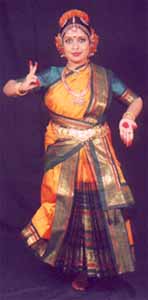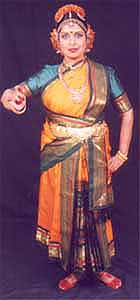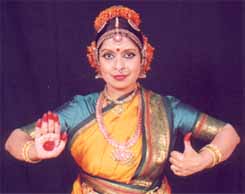Iconography of Murukan: Kinetic Art Forms
|
|
|
Bharata Natyam artist Dr. Malati Agniswaran depicting Murukan standing in Brahma sthanam (erect) with left hand in katyavalmpita mudra and right hand showing prayoga mudra for a sword (khadga) |
 |
|
Murukan with şakti-vel in the right hand with left hand showing varada mudra. The şakti-vel is shown as prayoga mudra with space between the fingers for the insertion of the vel. The hasta is kartarimukha. The deity is seated as indicated by the bent left leg as on an asana. |
Synopsis by Prof. (Smt.) Malati Agniswaran
To understand human activity which combines religion and art expressions of a community, one
must take cognizance of both written or textual tradition as well as unwritten
or oral traditions, for society is constantly evolving. The present paper is an
attempt to understand the iconography of Murukan through an interdisciplinary
approach combining both streams of religious tradition.
1. Relation
between iconography and dance
Iconography is a
visual representation of a divine concept. As the human body is the vehicle of
expression for şilpa, the artist draws his model from living human
forms. This has been amply illustrated. The hasta-s of dancers are
reflected in the hand postures of sculptures and paintings, and so also the sthanaka-s,
pādabheda-s etc. that are analyzed in
natya sastra and abhinaya darpana. The saustava posture of the deities
is the same as that seen in dance. This view is further strengthened by the
large number of sculptures of the temples in dance poses, and also by the
direct representation of the dance poses such as the kara-s in the
figures of the temples. Thus, silpa sastra and natya sastra can be said to be
twin disciplines, the principles of each influencing the other. Silpa is the
plastic representation of what would be visual kinetic representation in nrtta,
nrtya and natya.
2. Importance
of religion in the arts
All art forms in
the traditional Indian context stem out of the different religious strands of
the country. In temple sculptures and paintings the main import is to depict
the deities worshipped in the temple. In dance too religious sentiment is
intense, vibrant and pervasive. The ksipta position (Tamil: arai
manti) seen in Bharata Natyam (Tamil: pārata nattiyam) has a definite
correlation to the two triangles formed in the Nataraja representation of Siva
as the Divine Dancer. Almost all classical dance forms are temple arts. In
several instances in the traditional period, devadāsi-s were attached to temples as part of
the temple retinue that served the deity in the main sanctum.
3. Development
of legends in religion
In India, the
religion (that had no name in the ancient tradition) comprised the religious
beliefs of a community in a specific region. This implied further that the
deities in the different regions could be different, or that even the same
deity could have different legends woven around his concept, in different
communities in different regions. The idea of belief in varying legends of any
deity is acceptable to the Indian psyche.
4. Significance
of the regional legends in the arts
It is in this context that the
concrete expression of the sculptor or the dancer has to be understood. As the
art forms of India are derived from religion, the fount of inspiration for an
artist is his religious background. Skanda-Kārttikeya, Khandoba and Murukan are derived
from different legends. Therefore, in temples in different parts of the
country, the iconographic representations of the deity are different. This is
not only true for the plastic art expressions but also for kinetic art
expressions. In the dance form of puruliya chau in the North, Kārttika Bhagavan is only a warrior. In
Maharashtra, in the drama form of Vaghya Murali Jagarana, the tale of
the marriage of Khandoba with Banai and other related episodes are enacted. In
Tamil Nadu, in pārata nattiyam, the legends of arupatai
vitu and a few other regional legends are presented in the dance themes
pertaining to Murukan. For instance, in the case of Centil Murukan, the deity
referred to is the one in Tiruchendur.
Here the Lord is the warrior god who is
yet to marry Teyvayānai and Valli. The temple is by the
seashore and not on a hill as Murukan temples generally are. Therefore the
dancer cannot represent Centil Murukan through the imageries that would be
appropriate to Tiruttani Murukan. The same legends that inspire iconography
lead to the narrative element of the dance.
5. Interdisciplinary
approach in the study of culture
Hence there is systematic and
widespread evidence of interdependence between two systems of art, static and
kinetic. The stapati-s created iconographic representations in
accordance with the principles laid down in the S'ilpa S'āstra. The traditional dance gurus
choreographed dances through their knowledge perpetuated by oral traditions.
Narratives in dance and drama forms often derive their legends not only from
written sources but also from regional oral traditions. Only through such
interdisciplinary studies can a complex divine concept such as that of Murukan,
who is worshipped in different regions of India in different ways over a period
of several millennia, be understood in a comprehensive manner.
|
|
|
Bharata Natyam artist Dr. Malati Agniswaran depicting Murukan. The right hand shows abhaya mudra through the pataka hasta whereas the left hand show vel through the shikhara hasta. |
Qualifications: B.A. (Hons.) German, B.F.A., M.F.A. PH.D. (Dance); diplomas
in Saiva Siddhanta, Comparative Mythology and Theatre Arts.
Designation: Reader & Head of Dept. of Bharatanatyam, Nalanda Nritya Kala
Mahavidyalaya, Mumbai University.
|
Official address:
Nalanda Nritya Kala Mahavidyalaya,
Plot A-7/1, N.S. Road
No.10, J.V.P.D. Scheme
Ville Parle (West), Mumbai - 400 049 India
|
Residential address:
8/61, Shyam Nivas,
Bhulabhai Desai Road,
Mumbai - 400 026 India
|
Telephone: +91 364 9807/611 0003.
Telefax: 262 2028
E-Mail: agnimala@hotmail.com
|



